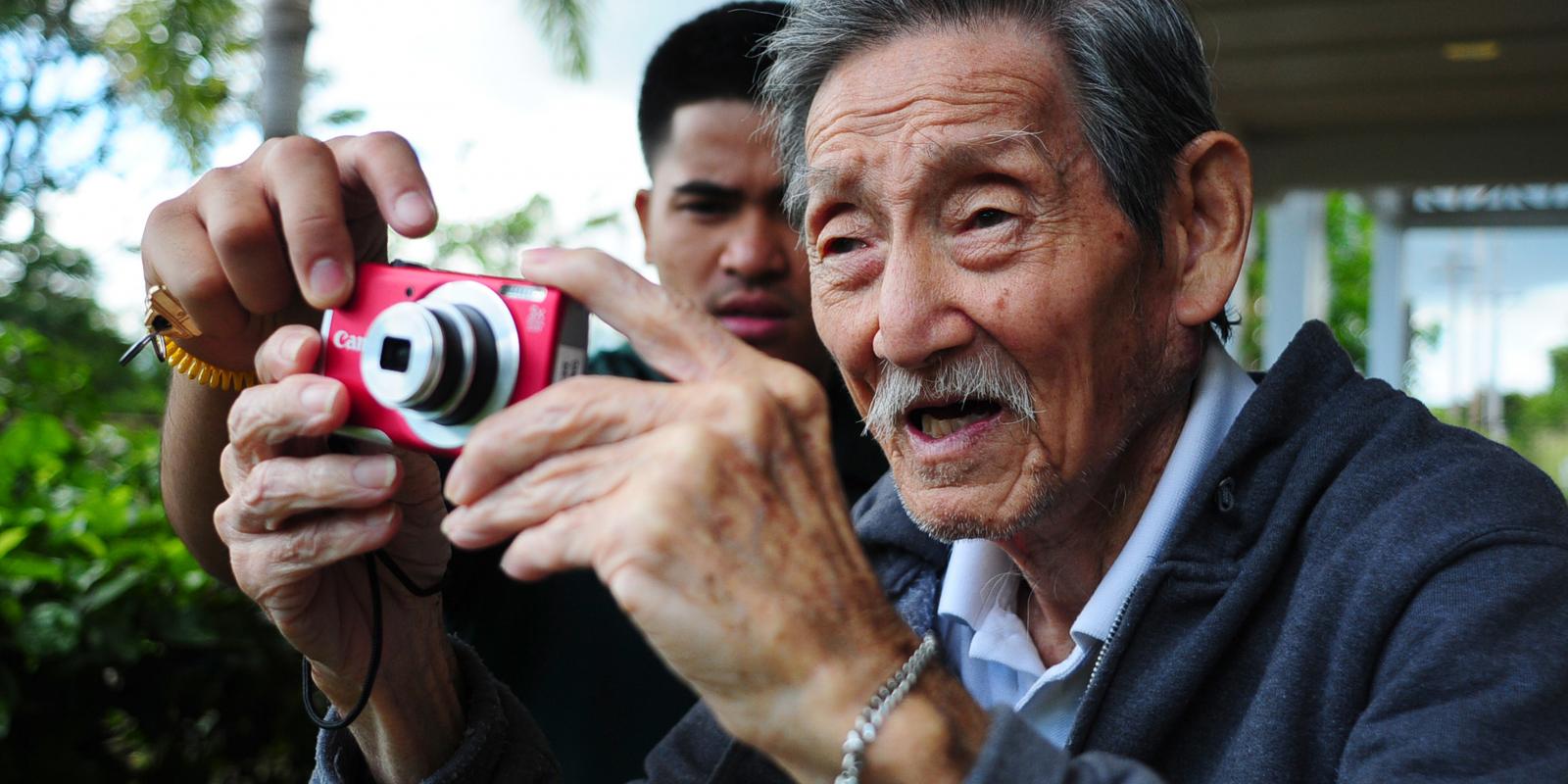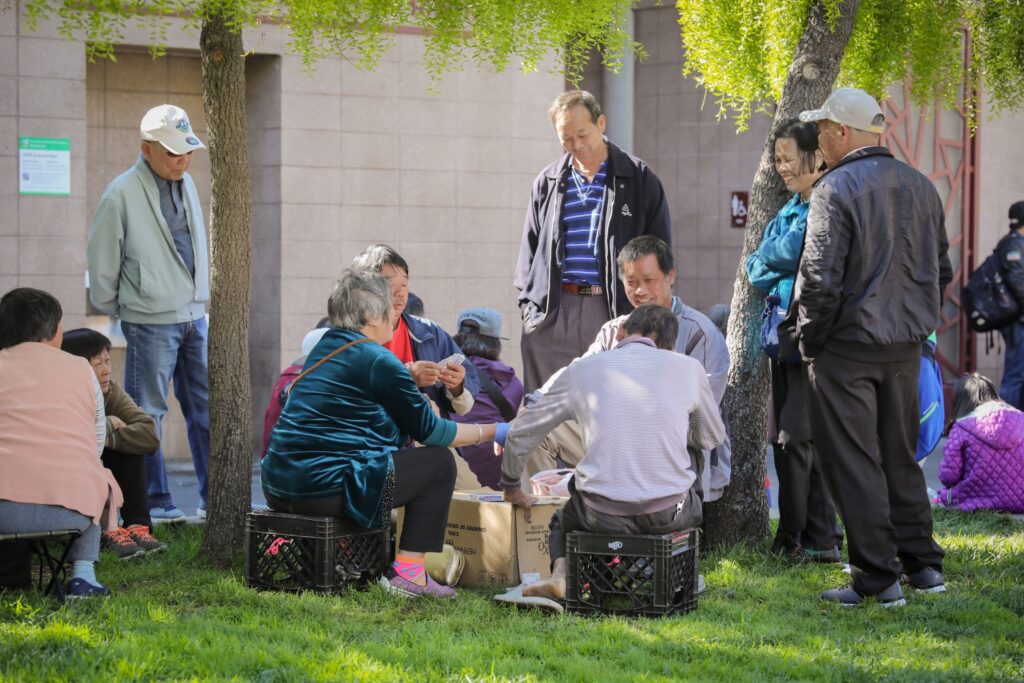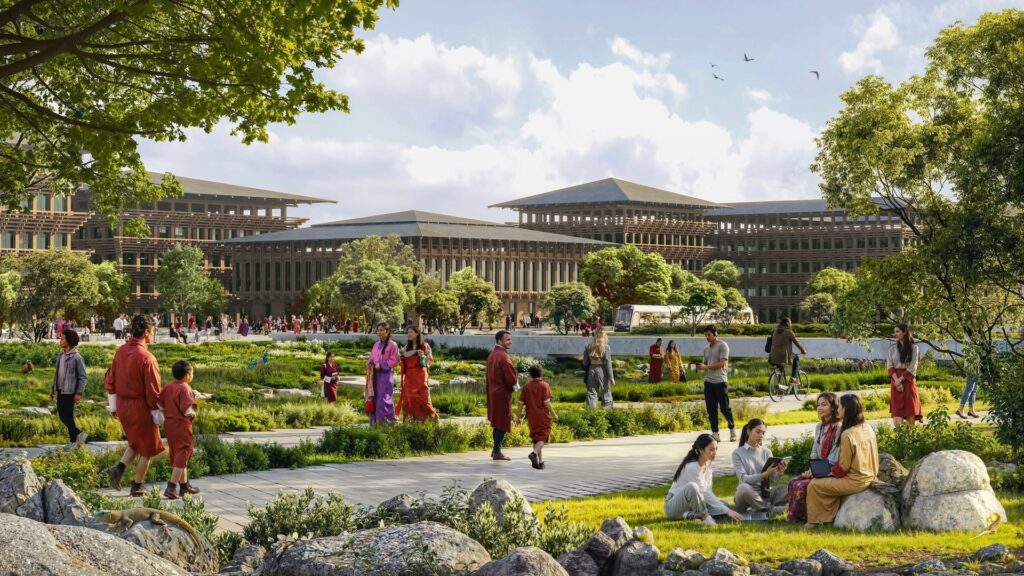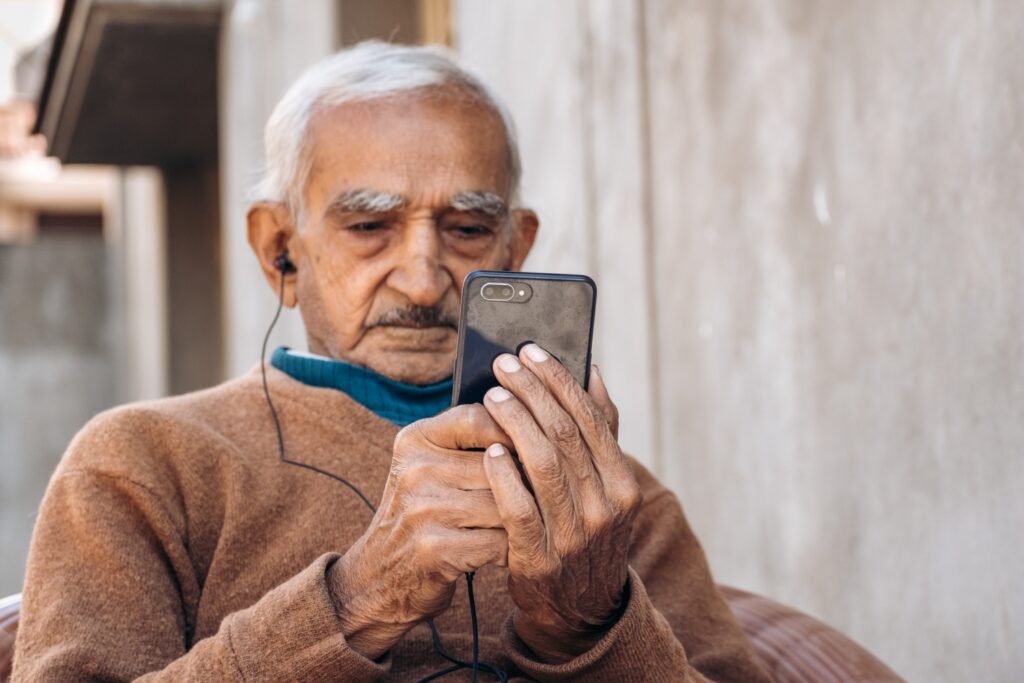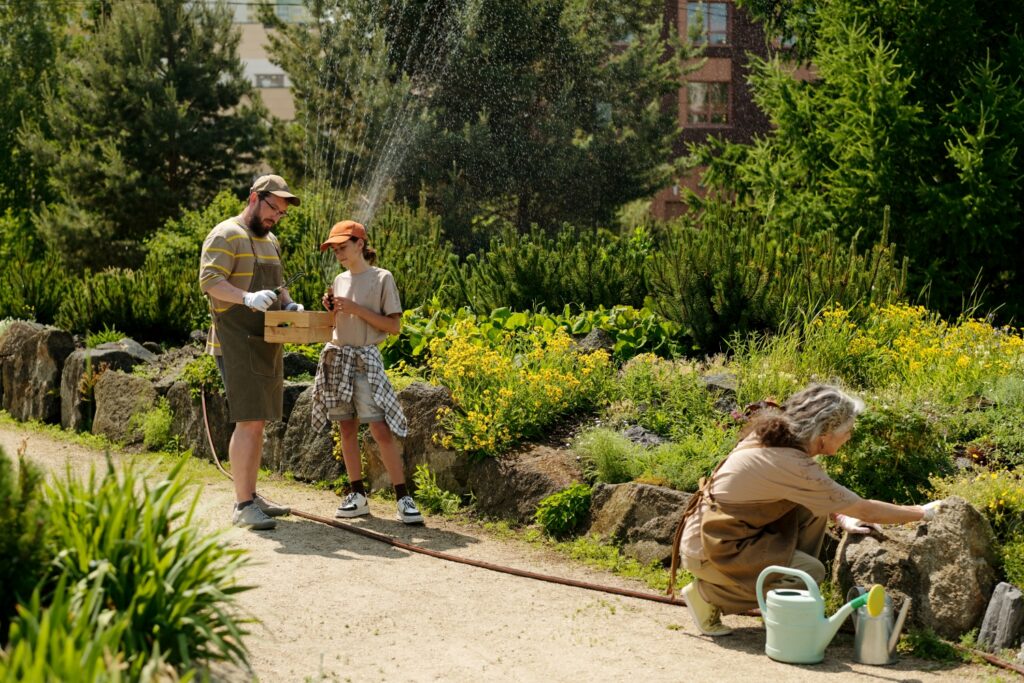Abstract:
Intergenerational programs and shared sites, when done well, help debunk ageism and combat the epidemic of loneliness and social isolation felt acutely by younger and older people. The benefits for every age have been documented and deserve further research. The rich diversity among these programs has only recently been intentionally elevated as a community strength. Encouraging policy makers and funders to use an intergenerational-solutions lens can accelerate the development of programs that build bridges between generations. Professionals in aging play a key role in championing intergenerational solutions in their communities.
Key Words:
Intergenerational, diversity, advocacy, service, belonging, older adult, youth, community-planning
Age segregation results in a frayed social compact and reinforces ageism by unfairly categorizing the young and the old. Our bookend generations are marginalized and overlooked for the critical role they play in holding our civil society together today—not just yesterday or tomorrow. Policies, programs, and services that keep generations apart ignore what research and practice demonstrate again and again—younger and older people survive and thrive together (Generations United, 2021).
Changing age-segregated institutions and policies will nurture each generation and our interdependence. Age integration would chip away not just at ageism, but at a host of other “isms,” too, and intergenerational programs’ shared use of spaces bridge artificial divides. Often classified as soft, these approaches are not just nice but necessary as our demographics change and challenge us.
Evolution of Intergenerational Programs
Intergenerational programs are defined as programs, policies, and practices that increase cooperation, interaction, and exchange between people of different generations, allowing them to share their talents and resources, and support each other in relationships that benefit individuals and their community (Generations United, 2010).
These programs often are categorized by the direction of service, which includes young serving old, old serving young, and young and old serving together. Using these categories, however, can lead to overlooking a key element in the programs—reciprocity. Quality intergenerational programs are intentional, reciprocal, respectful, purposeful, and value people at all ages and stages of life. They are built with the understanding that all generations benefit when relationships are forged between people of different age groups (Generations United, 2021).
The concept of intentionally bringing generations together to serve as resources to each other and to their communities has become increasingly popular as a vehicle for addressing critical societal needs and strengthening cross-age relationships. Beginning in the 1960s with the Foster Grandparent and RSVP programs, early intergenerational programs focused primarily on dispelling age-related stereotypes, fostering cross-age understanding, reducing social isolation, and providing financial support for low-income elders (Henkin & Butts, 2012).
Now a part of AmeriCorps Senior, these early programs evolved with the changing interests of older adults and expanding opportunities. While the original Foster Grandparents may have been content to rock babies, today’s older adults are as likely to be interested in rocking the boat.
Intergenerational Connections Are Urgently Needed and Wanted
Intentionally creating opportunities for cross-generational engagement is vital today as our country confronts an epidemic of social isolation and loneliness that is felt most acutely by older and younger people.
In May 2023, the United States Surgeon General Dr. Vivek Murthy released a new Surgeon General Advisory calling attention to the public health crises of loneliness, isolation, and lack of connection in our country. The physical health consequences of poor or insufficient connection include a 29% increased risk of heart disease, a 32% increased risk of stroke, and a 50% increased risk of developing dementia for older adults. Additionally, lacking social connection increases risk of premature death by more than 60%. Loneliness and isolation increase the risk for individuals to develop mental health challenges in their lives, and lacking connection can increase the risk for premature death to levels comparable to smoking daily (Office of the Surgeon General, 2023).
‘Not only is connecting across generations good for all ages—it is what people want.’
In the report, Our Epidemic of Loneliness and Isolation, the Surgeon General (2023) proposed A National Strategy to Advance Social Connection. Two of the six pillars are especially germane to intergenerational solutions.
The first pillar, Strengthen Social Infrastructure, points out that connections are influenced by physical elements in a community such as parks, libraries, and other community spaces. It calls upon communities to design environments that establish and scale community connection programs and invest in bringing people together. A new guide published by the American Planning Association provides a roadmap to do just this (Katz & Kaplan, 2023).
The second pillar, which cuts across all the others, is to Cultivate a Culture of Connection. Connections to people and to place are key to promoting a sense of belonging. This sense of belonging is diminishing, as pointed out in a recent national survey that found 68% of Americans feel a sense of non-belonging in the country overall, a number that rises to 74% who feel a sense of non-belonging in their local community (Argo & Sheikh, 2023). Cultivating a sense of belonging can be accomplished through frequent positive interactions grounded in care and concern (Johnson, 2023). A sense of belonging is ripe for cultivation via intergenerational programs that often result in cross-age friendships.
Not only is connecting across generations good for all ages—it is what people want.
A 2017 Harris Survey conducted for Generations United and The Eisner Foundation found two in three adults would like to spend more time with people outside their age group. Nine out of 10 believe community programs that serve kids and older adults end up benefiting everyone. An overwhelming majority of adults—77%—wish there were more opportunities in their community for people from different age groups to meet and get to know one another. The survey also found 61% wanted parks, playgrounds, and recreation centers that cater to all ages, which points to a need to develop local infrastructure that support social infrastructure (Generations United & The Eisner Foundation, 2017).
Diversifying Intergenerational Programs
Flagship intergenerational programs and the pioneers who developed the field were a homogeneous group. Yet passing on culture, traditions, and skills from one generation to the next cuts across all racial and ethnic groups. With support from the RRF Foundation for Aging, Generations United launched the Diverse Intergenerational Programs Initiative to explore more deeply why documented intergenerational programs did not reflect the richness found in America and around the world.
The initiative aimed to identify, advance, and build intergenerational solutions through a lens of diversity, equity, and inclusion (DEI). As part of this initiative, Generations United established an advisory group to provide guidance and feedback, while developing tools and resources to honor the accomplishments of diverse intergenerational programs, encourage their development, support and elevate diverse practitioners and leaders in the field, and provide recommendations for programs seeking to elevate diversity internally and in their communities.
In 2022 the initiative began with a national “Survey of Programs Engaging Older and Younger People,” to assess the diversity of intergenerational programs in the United States. This mixed-methods survey revealed that despite the hardships imposed by COVID-19 and other structural issues, intergenerational programs had maintained efforts to enhance community between generations, while still measuring their impact. The survey also examined the perspectives of staff by race and ethnicity, which revealed unique needs and challenges (Gonzales et al., 2022).
Among the survey’s findings:
- The top goals of the programs were to instill a strong sense of community; combat social isolation; and increase self-esteem, trust among ages, and academic achievement.
- Racial and ethnic minority staff identified top program goals as increased presence of positive role models, enhanced physical or mental health, and a greater understanding of issues facing young and old.
- Programs noted the importance of including diverse groups in intentional intergenerational programming.
- Overall, the main programmatic challenges reported by the programs were COVID-19, engagement of older adults from traditionally marginalized communities, and fundraising.
Survey results indicated that a clear opportunity exists for greater engagement with existing and new intergenerational programs regarding how they practice DEI principles in programming, policies, evaluation, and funding (Gonzales et al., 2022). There is a need to increase efforts to highlight the work of diverse intergenerational programs and programs that are aspiring to be more diverse in their staffing practices and/or their desire to center traditionally marginalized communities via allyship.
‘Intergenerational shared sites are designed to strengthen the web of support that is so integral to families and communities.’
The survey was the foundation for our report Strengthening Cultural Responsiveness in Intergenerational Programs: Passion, Purpose, and Planning to Drive Equitable Change, released in 2023 (Generations United, 2023b). This report identifies culturally responsive intergenerational practices and provides recommendations for programs seeking to elevate diversity internally and externally. It also honors the accomplishments of diverse intergenerational programs, encourages their development, and supports diverse practitioners and leaders.
More than 150 intergenerational programs were identified during the process. A few examples of those programs include:
- Center for Healthy Aging in Reno, NV: Teach Me To Grow Healthy (TMTGH) is an intergenerational community gardening project focused on creating a usable community-oriented, culturally sensitive program that improves fitness, nutritional support, mental health and holistic care of Indigenous and Non-Native older adult and youth communities. At TMTGH’s garden, staff train the gardeners to engage in cross-cultural dialogue and encourage intergenerational work and story-sharing, while older adults and young people together learn how to grow, harvest, and distribute ancestral Indigenous foods and plants.
- Sharing Time with Elders Project (STEP) in Tumwater, WA: STEP is a volunteer program inspiring people to bridge intergenerational gaps through powerful conversations. It has partnered with the Squaxin Island and Nisqually tribes for The Elder Project, which includes an Indigenous oral history sharing project, intergenerational conversations via Zoom, and a Native elders-in-classrooms project. The goal is to capture stories and document them for future generations.
- Koreatown Youth & Community Center’s (KYCC) Storytelling Program in Los Angeles, CA: KYCC is an intergenerational, multilingual, and multiethnic oral history and digital media program that teaches ethnographic and storytelling techniques to high school students and elders to investigate cultural practices and racial, economic, and health inequities in their community.
- Portland Youth and Elders Council in Portland, OR: This is a grassroots advocacy group open to everyone interested in building a strong civic connection with the local Native American community. Through intergenerational gatherings and the practice of traditional values, the Youth and Elders Council addresses local poverty and other issues by focusing on community solutions to housing, employment, education, health, and racism, while building on community strengths.
- Reach Out in Upland, CA: This nonprofit’s mission is to strengthen communities by bringing people together to solve the region’s toughest issues: breaking barriers to educational achievement; expanding economic opportunities; and creating safe, healthy, and innovative communities. The program hosts networking events for young Latinx professionals and retirees with similar career interests and experience.
- Mi Casa, Inc., Genesis Intergenerational Program in Washington, DC: At this intergenerational housing development, young Black mothers who grew up in foster care live alongside Black elders in an affordable housing development that includes a community kitchen, meeting room, library, and garden.
Elevating Shared Spaces and Places
When cultural anthropologist and author Mary Pipher was named one of Next Avenue’s 2019 Top Influencers in Aging, she was asked what she would like to see in the future. She responded, “I would like to see integrated public spaces, and integrated schools for ages two to eighty. I would like to see everything be multi-generational, so there would be many opportunities to connect within communities. I’d like to do away with our age-segregated society” (Next Avenue, 2019).
Pipher advocated for rethinking how spaces and places are designed so they become hubs for connection, not single-age isolation. Not surprisingly, she isn’t the only one interested in the concept of intergenerational shared sites. A 2018 survey conducted by the Harris Poll found that 4 in 5 Americans say that if they or a loved one needed care, they would prefer a setting where they can interact with people of different age groups verses a single age group. The vast majority (89%) thought that serving both children/youth and older adults at the same location is a good use of resources. (Generation United & The Eisner Foundation, 2018).
Intergenerational shared sites are settings where children, youth, and older adults participate in services and/or programs concurrently at the same site or on the same campus. Participants interact during regular planned intergenerational activities, as well as through informal encounters. In addition to shared sites, these settings can be referred to as intergenerational spaces, centers, parks, and more. Research has shown that using facilities and outdoor spaces to connect generations benefits the participants, families, and communities (Generations United & the Eisner Foundation, 2021).
One foundation offered a limited amount of funding for programs serving young or old and double that amount for proposals to engage more than one generation.
Using an age-integrated rather than age-segregated approach, intergenerational shared sites are designed to strengthen the web of support that is so integral to families and communities. In these facilities, people of different ages come together to learn, play, and grow. Shared sites are more than physical places; they are shared spaces that have collective meaning for participants of different ages. Their relational focus differentiates them from multigenerational sites, which are designed primarily to accommodate the needs and abilities of different age groups but not necessarily promote cross-age interaction (Generations United & the Eisner Foundation, 2021).
Inspiring examples include:
- Grace Living Center in Jenks, OK, where two Jenks Public Schools’ West Elementary pre-kindergarten and kindergarten classrooms are co-located with a skilled nursing facility. The “littles” (children) and the “Grands” (older adult residents) engage regularly in reading, shared study, dramatic play, gardening, friendly visiting in residents’ rooms, music, and ice cream socials.
- Little Tokyo Service Center in Los Angeles, CA, created an intergenerational garden program at an affordable housing community that engages its senior services and after-school youth program. Their Suehiro Cafe (oldest business) and CRFT by Maki (newest business) have formed an intergenerational collaboration to encourage the transfer of business skills between young and old.
- Ebenezer Ridges in Burnsville, MN, is home to a skilled nursing facility, adult day care, and senior housing. They opened a childcare center to attract and retain staff. In 2019 they reported that 60% of the children in that center were employee’s children. They offer intergenerational activities, including sharing meals, friendly visits, music, science, technology, physical activity, and learning programs (Generations United & the Eisner Foundation, 2019).
Looking Forward
Around the country, young and old come together in exceptional intergenerational programs and sites that benefit everyone. Still, few of the programs are built to last or to scale and the sites often take years to develop. How do we make such programs the norm, encourage their expansion, and make them available to the large numbers of people who say this is what they want? Below are a few suggestions.
Encourage local government to make age integration a core value. Local zoning, ordinances, and covenants can limit intergenerational opportunities. Challenge community leaders, policy makers, and other influencers to use an intergenerational solutions lens that asks simple questions such as those based on principles identified to advance intergenerational policies. These include:
- Make lifetime well-being for all generations the highest priority.
- Consider the impact of every action on each generation.
- Unite rather than divide the generations for the greatest social and financial impact.
- Recognize and support every generation’s ability to contribute to the well-being of their families and communities.
- Actively promote the interdependence of the generations (Generations United, 2023a).
Encourage federal policymakers. One of the most valuable assets you have is your vote. As a constituent, your elected officials know they need your support and will listen to you. Use your voice to help them understand smart investments in people of one generation reap benefits for those in other generations in the form of a stronger workforce and by ensuring quality of life and well-being. They will make America more competitive and help achieve fiscal sustainability. If we neglect thoughtful investments across the lifespan and abandon support for the growing interdependence of generations, we risk failure in the form of wasteful spending, increased public divisiveness, and policies injurious to American families and communities.
A good example of where to begin is by encouraging your representatives to support appropriating funds for intergenerational shared sites and multigenerational services projects authorized in the 2020 Older Americans Act through the Grant Program for Multigenerational Collaboration and support the 2024 reauthorization of the Older Americans Act, with increased supports for intergenerational shared sites and programs (Generations United, 2023a).
Encourage the proliferation of intergenerational shared sites and spaces. Licensing, codes, regulations, and funding streams often stymie the development of shared sites. Tenacious visionaries find ways around the roadblocks but many others are disheartened and give up on their dreams to engage young and old under one roof or in a single outdoor space. We need to elevate and emulate the proven models and identify champions who can help.
Encourage funders to weave their priorities. Community and family foundations can promote intergenerational integration by incorporating language that gives preference to potential grantees who propose to leverage the strengths of each generation. For example, years ago a local foundation in Florida offered a limited amount of funding for programs that served young or old and double that amount if the prospective grantee proposed to serve or engage more than one generation. Their request for proposals became a pathway to encourage intergenerational solutions (Generations United, 2008).
The St. David’s Foundation in Austin, TX, took a deeper dive and developed a funding stream for intergenerational programs (St. David’s Foundation, 2023). Wanting to expand beyond serving older adults in need, under the leadership of Andrew Levack, St. David’s Foundation started with training for its grantees and potential grantees that included teaching the elements of quality programing and providing access to program development tools. Once funded, the foundation began to build a learning community among its grantees and provided individual technical assistance as they implemented or expanded their programs.
Expand your social circle. Change begins with individuals. The belonging survey and Generations United/The Eisner Foundation surveys found a deep desire to connect with others but a helplessness when it came to how. Don’t wait for an invitation, make your way. It doesn’t need to be a formal intergenerational program. Examples include book clubs, service projects, community fairs, attending school sporting events or theatre, hosting baby showers for military families, providing transportation for students or seniors, tutoring new immigrants as they prepare for citizenship tests, and so much more. Connecting across a shared interest helps bridge the divide more quickly. Start with a baby step. You’ll soon learn it’s worth the effort.
Donna M. Butts is the executive director of Generations United, headquartered in Washington, DC.
Photo credit: Generations United/Colby Takeda
Photo caption: A young adult helps an older adult work his camera.
References
Argo, N., & Sheikh, H. (2023). The belonging barometer: The state of belonging in America. American Immigration Council and Over Zero. https://www.americanimmigrationcouncil.org/research/the-belonging-barometer
Generations United. (2008). Stronger together: A call to innovation for funders of children, youth, families, and older adults. https://www.gu.org/app/uploads/2018/05/Intergenerational-Report-StrongerTogetherFundersCallToInnovation.pdf
Generations United. (2010). Intergenerational program certification. https://www.gu.org/projects/program-certification/
Generations United. (2021). Making the case for intergenerational programs. https://www.gu.org/app/uploads/2021/03/2021-MakingTheCase-WEB.pdf
Generations United. (2023a). Generations United policy priorities for the 118th Congress. https://www.gu.org/app/uploads/2023/02/GU-118th-PPA-Final-PDF.pdf
Generations United. (2023b). Strengthening cultural responsiveness in intergenerational programs: Passion, purpose, and planning to drive equitable change. https://www.gu.org/resources/strengthening-cultural-responsiveness-in-intergenerational-programs/
Generations United, & The Eisner Foundation. (2017). I need you, you need me: The young, the old and what we can achieve together. https://www.gu.org/resources/i-need-you-you-need-me-the-young-the-old-and-what-we-can-achieve-together/
Generations United, & The Eisner Foundation. (2018). All in together: Creating places where young and old thrive. https://www.gu.org/app/uploads/2018/06/SignatureReport-Eisner-All-In-Together.pdf
Generations United, & The Eisner Foundation. (2019). The best of both worlds: A closer look at creating spaces that connect young and old. https://www.gu.org/app/uploads/2019/06/Intergenerational-Report-BestofBothWorlds.pdf
Generations United, & The Eisner Foundation. (2021). Sharing our space: A toolkit for developing and enhancing intergenerational shared sites. http://www.sharingourspace.org/
Gonzales, E., Kruchten, R., Patrick, E., & Steinig, S. (2022). A Survey of Diversity of Intergenerational Programming: Generations United and NYU. The Center for Health and Aging Innovation Issue Brief hdl.handle.net/2451/65752
Henkin, N. Z., & Butts, D. M. (2012). Intergenerational practice in the United States: Past, present and future. Quality in Ageing and Older Adults, 13(4). https://www.emerald.com/insight/publication/issn/1471-7794/vol/13/iss/4
Johnson, T. R. (2023, March 21). Why so many Americans feel left out. The Washington Post. https://www.washingtonpost.com/opinions/2023/03/21/why-americans-feel-left-out/
Katz, I., & Kaplan, M. S. (2023). Intergenerational community planning. American Planning Association. https://www.gu.org/resources/intergenerational-community-planning/
Next Avenue. (2019). 2019 Influencers in aging. https://www.nextavenue.org/series/2019-influencers-in-aging/
Office of the Surgeon General. (2023). New surgeon general advisory raises alarm about devastating impact of loneliness and isolation in the United States. U.S. Department of Health and Human Services. https://www.hhs.gov/about/news/2023/05/03/new-surgeon-general-advisory-raises-alarm-about-devastating-impact-epidemic-loneliness-isolation-united-states.html
St. David’s Foundation. (2023). Older adults aging in place. https://stdavidsfoundation.org/grantmaking/strategic-priorities/older-adults-age-in-place/

